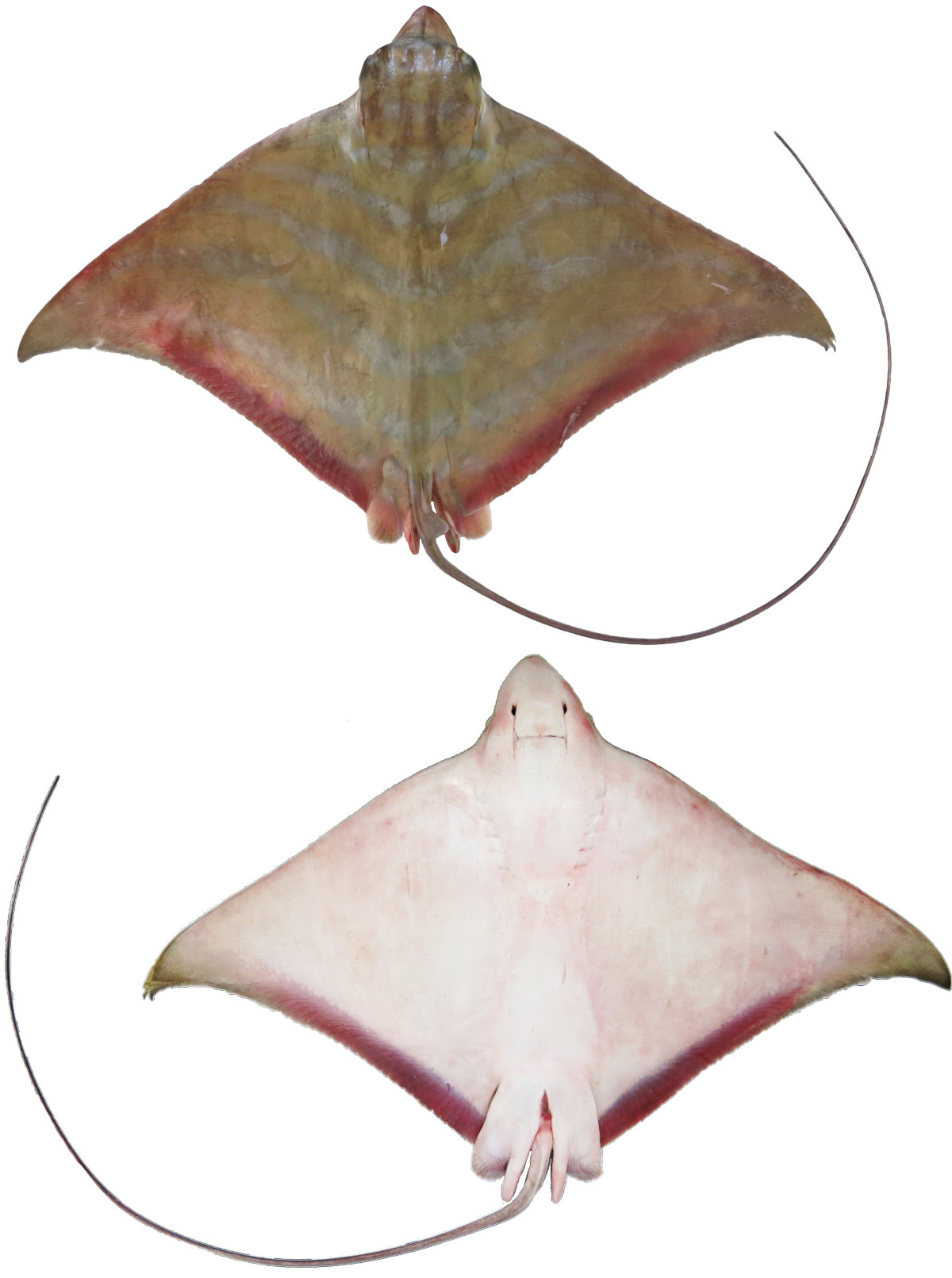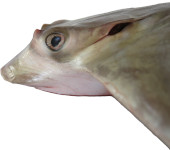Aetomylaeus wafickii
Jabado, Ebert & Al Dhaheri, 2022
Classification: Elasmobranchii Myliobatiformes Myliobatidae
Reference of the original description
Resolution of the Aetomylaeus nichofii species complex, with the description of a new eagle ray species from the northwest Indian Ocean and a key to the genus Aetomylaeus (Myliobatiformes: Myliobatidae). Marine Biodiversity, 52, Article 15
Resolution of the Aetomylaeus nichofii species complex, with the description of a new eagle ray species from the northwest Indian Ocean and a key to the genus Aetomylaeus (Myliobatiformes: Myliobatidae). Marine Biodiversity, 52, Article 15
Types
Aetomylaeus wafickii
Holotype: CAS: 246088; Paratype: CAS: 246089; CAS: 246090; CAS: 246091; CAS: 246092; CAS: 246093; MCZ: 173321; USNM: 443690; USNM: 443691;
Aetomylaeus wafickii
Holotype: CAS: 246088; Paratype: CAS: 246089; CAS: 246090; CAS: 246091; CAS: 246092; CAS: 246093; MCZ: 173321; USNM: 443690; USNM: 443691;
Description :
Citation: Aetomylaeus wafickii Jabado, Ebert & Al Dhaheri, 2022: In: Database of modern sharks, rays and chimaeras, www.shark-references.com, World Wide Web electronic publication, Version 12/2025
Please send your images of "Aetomylaeus wafickii" to info@shark-references.com

Aetomylaeus wafickii Jabado, Ebert & Al Dhaheri, 2022, holotype, CAS 246088, adult male, 411 mm DW, fresh. Photograph courtesy Marsha Englebrecht © Jabado, Ebert & Al Dhaheri, 2022

Aetomylaeus wafickii Jabado, Ebert & Al Dhaheri, 2022, holotype, CAS 246088, adult male, 411 mm DW, fresh. Photograph courtesy Marsha Englebrecht © Jabado, Ebert & Al Dhaheri, 2022
Common names
 Wafc’s Eagle Ray, Lukhmat Wafc (arabic)
Wafc’s Eagle Ray, Lukhmat Wafc (arabic)
 Wafc’s Eagle Ray, Lukhmat Wafc (arabic)
Wafc’s Eagle Ray, Lukhmat Wafc (arabic)
Short Description
Original diagnosis of Jabado, Ebert & Al Dhaheri, 2022 [30504]: Aetomylaeus wafckii sp. nov. is a small-sized species (maximum size of 73 mm DW) distinguished from congeners based on the following combination of characters: dorsal coloration light brownish, with eight to ten transverse pale bluish to light grey bands (Fig. 9), occasionally dark-edged, without dark spots or blotches; ventral surface, including rostral lobe and nasal curtain, whitish with dusky to darker pectoral-fn tips and narrow dark outer margins; a short tail (0.9–1.6%DW) even when not damaged or broken; no stinging spine; tooth plates in 13 rows upper jaw, 15 rows lower jaw; pectoral fn radials; pelvic fn radials males 14–16 (excluding claspers), females (16–19); total vertebral counts (including synarcual) (79–93); males mature by 41 cm DW, females mature by 55 cm DW.
Original diagnosis of Jabado, Ebert & Al Dhaheri, 2022 [30504]: Aetomylaeus wafckii sp. nov. is a small-sized species (maximum size of 73 mm DW) distinguished from congeners based on the following combination of characters: dorsal coloration light brownish, with eight to ten transverse pale bluish to light grey bands (Fig. 9), occasionally dark-edged, without dark spots or blotches; ventral surface, including rostral lobe and nasal curtain, whitish with dusky to darker pectoral-fn tips and narrow dark outer margins; a short tail (0.9–1.6%DW) even when not damaged or broken; no stinging spine; tooth plates in 13 rows upper jaw, 15 rows lower jaw; pectoral fn radials; pelvic fn radials males 14–16 (excluding claspers), females (16–19); total vertebral counts (including synarcual) (79–93); males mature by 41 cm DW, females mature by 55 cm DW.
Distribution
Northwest Indian Ocean from Kuwait in the Arabian Gulf to Pakistan in the Arabian Sea and south to Sri Lanka (personal observation based on photos collected from various researchers in the region (Iran, Saudi Arabia, Pakistan; Daniel Fernando, Blue Resources Trust, pers. comm. January 2018). It has also been reported from Oman (Reeve et al. 2011; Henderson et al. 2016) and westwards to the southern Red Sea of Saudi Arabia (Spaet and Berumen 2015). [30504] Source: www.gbif.org
Northwest Indian Ocean from Kuwait in the Arabian Gulf to Pakistan in the Arabian Sea and south to Sri Lanka (personal observation based on photos collected from various researchers in the region (Iran, Saudi Arabia, Pakistan; Daniel Fernando, Blue Resources Trust, pers. comm. January 2018). It has also been reported from Oman (Reeve et al. 2011; Henderson et al. 2016) and westwards to the southern Red Sea of Saudi Arabia (Spaet and Berumen 2015). [30504] Source: www.gbif.org
Dentition
Teeth in 13 rows in upper jaw and 15 rows in lower jaw, coalesced to form plates; middle series of teeth in both jaws broad and hexagonal, fanked by two to three smaller rows, slightly larger posteriorly and hexagonal with small diamond-shaped teeth anteriorly and arranged in a pavement-like fashion; frst row of lower jaw narrowed and not fanked with smaller rows; median tooth row transverse in lower jaw and chevron-shaped in upper jaw with a slight curve; median tooth row 6–8 times width of lateral tooth rows; lower jaw tooth plate width 3.2 (3.4–4.2)% DW, upper jaw tooth plate width 3.6 (3.1–4.3)% DW. Lower jaw tooth plate width: top: 2 mm, middle: 14 mm, bottom: 19 mm; length: 22 mm [30504]
Teeth in 13 rows in upper jaw and 15 rows in lower jaw, coalesced to form plates; middle series of teeth in both jaws broad and hexagonal, fanked by two to three smaller rows, slightly larger posteriorly and hexagonal with small diamond-shaped teeth anteriorly and arranged in a pavement-like fashion; frst row of lower jaw narrowed and not fanked with smaller rows; median tooth row transverse in lower jaw and chevron-shaped in upper jaw with a slight curve; median tooth row 6–8 times width of lateral tooth rows; lower jaw tooth plate width 3.2 (3.4–4.2)% DW, upper jaw tooth plate width 3.6 (3.1–4.3)% DW. Lower jaw tooth plate width: top: 2 mm, middle: 14 mm, bottom: 19 mm; length: 22 mm [30504]
Remarks
shark-references Species-ID=16230:
shark-references Species-ID=16230:


















